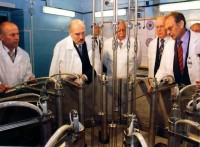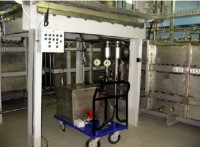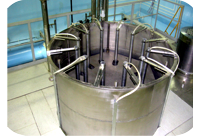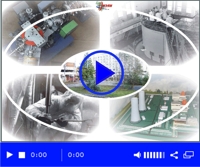The Critical Facility “Hyacinth”
 The Institute has an experience of over thirty years in designing, constructing, operating and conducting experimental research on the basis of critical stands. In the process of performing works in the framework of large-scale projects dealing with development, design and operation of power reactor facilities for various applications, the Institute has accumulated scientific and engineering potential that can be used in experimental research. In 2007 following an order by the President of the Republic of Belarus, the Institute’s specialists created a multi-purpose critical facility Hyacinth intended for studying neutron multiplication systems and performing various works for the national economy of Belarus. The critical stand Hyacinth provides experimental base for solving a broad range of problems related to development of nuclear power technologies, both basic and applied, such as:
The Institute has an experience of over thirty years in designing, constructing, operating and conducting experimental research on the basis of critical stands. In the process of performing works in the framework of large-scale projects dealing with development, design and operation of power reactor facilities for various applications, the Institute has accumulated scientific and engineering potential that can be used in experimental research. In 2007 following an order by the President of the Republic of Belarus, the Institute’s specialists created a multi-purpose critical facility Hyacinth intended for studying neutron multiplication systems and performing various works for the national economy of Belarus. The critical stand Hyacinth provides experimental base for solving a broad range of problems related to development of nuclear power technologies, both basic and applied, such as:
- basic research in nuclear reactor physics and health physics, fissile material criticality and nuclear safety;
- applied research to support development of new-generation nuclear reactors for power plants and miscellaneous nuclear plants;
- research to support development of control and diagnostics software/hardware for reactor facilities based on technological noise analysis;
- testing of radio-electronic devices for tolerance to gamma-ray and neutron emissions;
- provision of training and methodological experimental facilities for training specialists in the field of nuclear power and application of ionizing radiation;
- development of mutually benefitial scientific and technical cooperation with foreign nuclear centers.
The critical stand incorporates: 
- a critical assembly that can be used for studying physical properties of nuclear reactor cores with a liquid moderator (water etc.), a solid moderator (zirconium hydride etc.) and without a moderator;
- a control and protection system;
- a hydraulic system for operations with a liquid moderator;
- a system for collection, processing and storage of experimental data;
- a radiation control and radiological monitoring system;
- a communications and CCTV system;
- a physical protection system;
- a number of other utilities required for supporting operation of the facility.
 The critical facility has been created using advanced technological equipment and sophisticated measuring devices, most of which have been developed specifically for this facility.
The critical facility has been created using advanced technological equipment and sophisticated measuring devices, most of which have been developed specifically for this facility.
When conducting experiments with critical assemblies, researchers use the system for collection, processing and storage of experimental data that consists of PCs linked into a LAN, the subsystems for signal pre-processing and data collection KAMAK and SEXI, and the experimental facilities.
The named software/hardware system is used for measuring neutronic characteristics of critical assemblies, such as reactivity, margin reactivity, control efficiency, nuclear reaction rates, power density distributions, prompt-neutron lifetime, effective fraction of delayed neutrons and absolute power output.
In the near future, it is intended to use the Hyacinth for conducting benchmark experiments in the criticality of neutron multiplication systems on the basis of uranium with various enrichment levels, with water and zirconiumhydride moderators and with no moderator, and for experiments in the physics and safety of innovation nuclear reactors intended for various applications (including those with a core of small-diameter ball-type fuel elements), etc.






